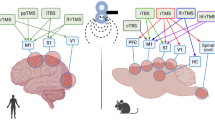Abstract
The probability of movements in response to light flashes, the conditional signal of a defense reflex, did not alter against the background of the action of dilantin (D) in a dose which, according to published data, attenuates posttetanic potentiation (PTP). A weak but stable disinhibition of the motor reaction was observed in response to flashes turned on against the background of conditional inhibition, continuous light. The activation of neurons of sensorimotor cortex in response to reinforced and nonreinforced light flashes against the background of D was intensified in the same way as was observed previously as exemplified by the reactions of neurons of the visual cortex [3], while it was diminished in response to painful reinforcement. The acceleration of impulses in response to reinforced light flashes under the influence of D became weaker in the hippocampus, by contrast with neurons of the new cortex. It can be concluded on the basis of the data obtained that PTP does not participate in the storage in the new cortex of long-term memory of the biological significance of an activating stimulus.
Similar content being viewed by others
References
L. L. Voronin, “Elementary and minimal postsynaptic potentials,”Usp. Fiziol. Nauk,11, No. 1, 19 (1980).
R. G. Kozhedub, “Long-term changes in synaptic activity and cellular excitability during learning,”Zh. Vyssh. Nerv. Deyat.,39, No. 4, 675 (1989).
G. I. Shul’gina, “The influence of dilantin on the reactions of the visual cortex and the behavior of rabbits during learning,”Zh. Vyssh. Nerv. Deyat.,44, No. 1, 48 (1994).
E. M. Adler, Y. Yeari, G. David, and M. E. Selzer, “Frequency-dependant action of phenytoin on lamprey spinal axons,”Brain Res.,362, 271 (1986).
R. J. DeLorenzo, “Calmodulin systems in neuronal excitability: a molecular approach to epilepsy,”Ann. Neurol.,16, 104 (1984).
D. W. Esplin, “Effects of diphenylhydantoin on synaptic transmission in cat spinal cord and stellate ganglion,”J. Pharmacol. Exptl. Therap.,120, 301 (1957).
W. D. Matthews and J. D. Connor, “Effect of diphenylhydantoin on interhippocampal evoked responses,”Pharmacologist,16, 228 (1974).
M. E. Selzer, G. David, and Y. Yeari, “On the mechanism by which phenytoin blocks posttetanic potentiation at the frog neuromuscular junction,”J. Neurosci.,5, 2894 (1985).
J. E. P. Toman, “The neuropharmacology of antiepileptics,”EEG Clin. Neurophysiol.,1, 33 (1949).
Additional information
Institute of Higher Nervous Activity and Neurophysiology, Russian Academy of Sciences, Saint Petersburg. Translated from Zhurnal Vysshei Nervnoi Deyatel’nosti imeni I. P. Pavlova, Vol. 44, No. 4-5, pp. 714–720, July–October, 1994.
Rights and permissions
About this article
Cite this article
Shul’gina, G.I. Influence of dilantin on the reactions of neurons of the sensorimotor cortex and hippocampus during learning. Neurosci Behav Physiol 25, 413–418 (1995). https://doi.org/10.1007/BF02359598
Received:
Revised:
Issue Date:
DOI: https://doi.org/10.1007/BF02359598




